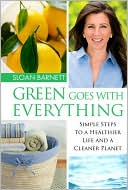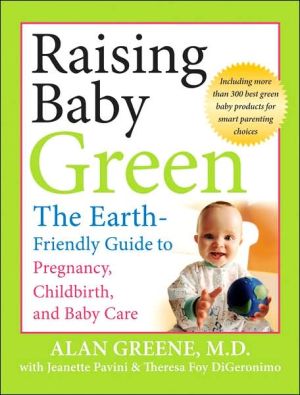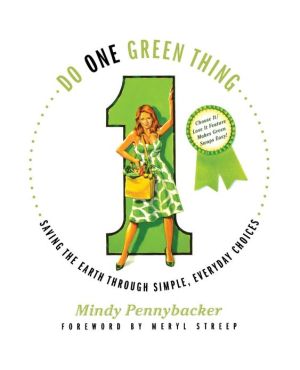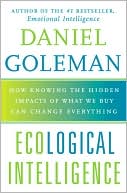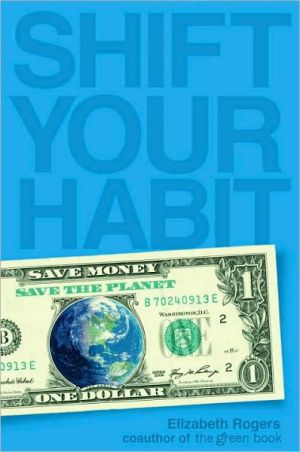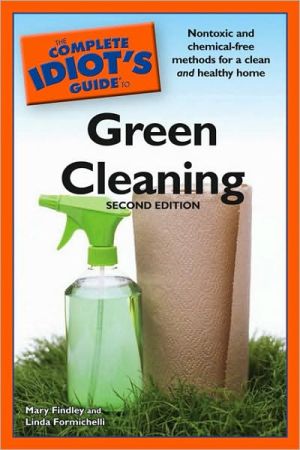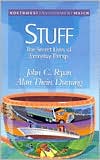Growing Up Green! Baby and Child Care (Green This! Series), Vol. 2
The essential, parent-friendly guide to raising a healthy child in our increasingly toxic environment. \ The second volume in the New York Times bestselling Green This! series, Growing Up Green: Baby and Child Care is a complete guide to raising healthy kids. Environmental activist and children's advocate Deirdre Imus addresses specific issues faced by children in every age group -- from infants to adolescents and beyond. With a focus on preventing rather than treating childhood illnesses,...
Search in google:
The essential, parent-friendly guide to raising a healthy child in our increasingly toxic environment.The second volume in the New York Times bestselling Green This! series, Growing Up Green: Baby and Child Care is a complete guide to raising healthy kids. Environmental activist and children's advocate Deirdre Imus addresses specific issues faced by children in every age group — from infants to adolescents and beyond. With a focus on preventing rather than treating childhood illnesses, Deirdre concentrates on educating and empowering parents with information such as: • How to make sure your child is vaccinated safely• Which plastic bottles and toys are least toxic • How to lobby for safer school environments and support children's environmental health studies• Advice from leading "green" pediatricians and nationally recognized doctors such as Mehmet C. Oz, M.D. Chock-full of research and advice, Growing Up Green makes it easy for you to introduce your child to the "living green" way of life. Janet Clapp - Library Journal Imus (founder & president, Deirdre Imus Environmental Ctr. for Pediatric Oncology) presents her second volume (following Green This!: Greening Your Cleaning) in her "Green This!" series. Here, she emphasizes the active role parents must play to ensure their children's health, from prepregnancy through adolescence; explains how toxins in our food and the environment can cause health problems like asthma, autism, and cancer; and cites worrisome statistics about the chemicals in our lives. Sharing her own experiences raising her son and running (along with her husband, radio host Don Imus) the Imus Ranch, a cattle ranch for kids with cancer, she further discusses the importance of organic food, the dangers of plastics, and the hazards of some vaccines. Resources include recipes, a glossary, recommended reading, web sites selling green products, and biographies of the various medical experts and researchers she consults. Imus writes not only as an educated consumer with spending power but as a citizen willing to advocate for children's health. She encourages readers to regard themselves in that same light and concludes with a call to action. Recommended for libraries where there is interest in this topic.
\ Chapter 1\ A Letter to Parents\ Half a century ago, most parents had a pretty good sense of their responsibilities toward their children: to provide them with food, clothing, shelter, an education, and, of course, love. Like parents throughout history, they did whatever was in their power to keep their children safe, to protect them from harm.\ But what does it mean today, to "keep our children safe"? In recent years, the job of raising -- and protecting -- our children seems to have become a lot more complicated. Our lifestyles have undergone radical changes over the past few decades, and so has the environment we live in.\ As a culture, we seem to be in constant motion. We work more, and sleep less, than ever before. Instead of making time for a good old-fashioned sit-down dinner at home, we opt for the drive-in window of the nearest fast-food restaurant. We live off processed foods loaded with sugars, synthetic additives, and trans fats. We skip our morning walk and instead spend hours of every day locked inside our cars or plugged into various electronic devices.\ And perhaps most significantly, harmful toxins have become more and more present in our environment. Every week, more chemicals are introduced into our environment, often without first being tested for safety on humans, much less safety on children. These toxins pervade every aspect of our lives: the air we breathe, the water we drink, even the clothes we wear. We spray our lawns with pesticides, and eat fish contaminated with mercury, and drink milk pumped up with hormones. We sleep on mattresses treated with bioaccumulative flame retardants and scrub our kitchens -- and our faces -- with irritating chemicals. We're inundating ourselves with toxins twenty-four hours a day, seven days a week, and most of the time we don't even know it!\ So what, you might be asking, does any of this have to do with raising a child?\ The answer is absolutely everything. Over the past thirty years, these changes in our lifestyle, diet, and environment have taken a dramatic -- and tragic -- toll on our children's health. We're seeing epidemic levels of diabetes and obesity. Pediatric cancers have risen steadily at a rate of 1 percent annually over the last twenty years. A poor diet and lack of exercise have contributed to an epidemic of childhood obesity, with one in six children in the United States between the ages of six and nineteen considered overweight. Asthma rates have increased tenfold over the last decade. Approximately one out of every six U.S. children has a developmental disability, including speech and language disorders, learning disabilities, and attention deficit/hyperactivity disorder (ADHD). Approximately 1 in 150 American children has an autism spectrum disorder (ASD).One out of every eight babies is born premature in this country, and the rate of premature births increased nearly 31 percent between 1981 and 2003. Rheumatoid arthritis has become the third-most-common childhood disease -- among infants. Childhood allergies are at record levels.\ If you're like me, you probably feel pretty horrified upon confronting these sobering facts for the first time. But I don't want this information to frighten or paralyze you. On the contrary: It should empower you to start asking some critical questions about what's causing this extraordinary increase in diseases over the last twenty-five years and what you as a parent can do to reverse these trends.\ The World Health Organization estimates that we could prevent more than 80 percent of all chronic illnesses by improving our lifestyles in simple ways, like working to reduce our exposure to environmental pollutants and eating a healthier diet. Eighty percent! So why aren't we doing more to protect our children?\ For a number of reasons, children are more adversely affected by exposure to environmental toxins than adults. Pound for pound of body weight, they breathe and eat more than we do. Their still-developing immune systems might mistakenly treat the toxins as naturally occurring enzymes or hormones. And because children are growing and developing so fast, dangerous cell mutations can multiply at a faster rate. Children are also less capable of detoxifying and excreting chemicals than adults. Their blood-brain barrier is still porous and allows more chemicals to reach their brains.\ The environmental toxins most harmful to children include:\ \ Mercury (in vaccines, fish, dental amalgams, coal-burning\ emissions, incinerators, landfills)\ Toxic cleaning products\ PCBs (polychlorinated biphenyls)\ Lead\ Air pollutants such as dioxins, volatile organic compounds\ (VOCs), asbestos\ Environmental and/or tobacco smoke\ Pesticides sprayed in the home and on the lawn\ Pesticides used in lice shampoos\ Pesticides in food and water\ Drinking water contaminants\ Industrial emissions\ \ Many children, particularly those in lower-income urban areas, face a number of these environmental insults on a regular basis, even daily. All I can say is no wonder their health is suffering. Their bodies are overloaded with toxins and deficient in the nutrients they need to develop properly. How could our kids not be chronically ill?\ As parents, and as a society, we need to become more vigilant about shielding our children from these environmental insults. We're already way past the tipping point. We can -- we must -- band together to reverse these frightening trends in our children's health.\ With that goal in mind, I've written this book for you -- all the concerned parents (and future parents) out there who are ready to take charge of their children's health once and for all. Greening Your Baby is a chronological, stage-by-stage guide that will take you from the moment you first entertain the possibility of having a child all the way through the moment when you send that child off into the "real world," whether that means college or the workplace. Whatever your level of parenting experience, if you have one kid or nine, you can use the information in these pages to secure a better future for your children.\ With the necessary tools, you can protect your children from environmental toxins. Throughout this book, I'll be examining how all sorts of different lifestyle choices -- about nutrition, physical fitness, even vaccinations -- may affect the development of your child. I've spoken to more than twenty of the most respected children's health experts in the country about the dangers toxins pose and the actions we can take to reduce kids' exposure to them.\ Though I was interested in these issues long before I became a mother, the birth of my son, Wyatt, deepened my determination to clean up our toxic environment. I wanted to give my son the best possible start in life, and I knew that doing so meant reducing his exposure to toxins. How could I help Wyatt and millions of kids like him?\ In 1998 -- the same year that I gave birth to Wyatt -- my husband and I realized a longtime dream when we founded the Imus Ranch in Ribera, New Mexico. That summer, and every summer since, we invited children suffering from cancer and various life-threatening blood disorders, such as sickle cell, and children who have lost a brother or sister to sudden infant death syndrome, to experience life on our authentic 1880s-style working cattle ranch.\ My experiences over the last decade at the ranch have strengthened my desire to leave our children, and their children, a cleaner world to inherit. We've now had more than seven hundred kids at the ranch, and I've learned a great deal from every single one of them. I like to think that this book reflects many of the lessons I've taken from my summers in New Mexico -- and from every day of the year as a mother.\ To me, it all boils down to knowing the right questions to ask and the choices that are available to you. Awareness is the essential tool here. Only when we truly educate ourselves about the widespread threats to our children's health can we take steps to avoid and ultimately eliminate those threats. With that goal in mind, in 2001, I founded the Deirdre Imus Environmental Center for Pediatric Oncology at the Hackensack University Medical Center in Hackensack, New Jersey, to raise people's awareness of the environmental factors that contribute to childhood cancer and other serious childhood diseases. In our campaign to reduce kids' exposure to environmental toxins, we place a big emphasis on the dangers of cleaning chemicals and pesticides in schools and homes. We believe that if more parents spoke out about the irreparable harm these substances were doing to our children, people would no longer use them.\ The time has come to raise our voices and demand some changes. If we continue bringing up our children in this toxic soup, their health problems will only worsen, and then what will we be left with as a society?\ Throughout this book, I've tried to make my suggestions as accessible, realistic, and affordable as possible, since I'm the first to acknowledge that most parents have too much on their plates for any complicated life-turnaround scheme. Even if, like so many families today, you and your partner both have full-time jobs, I promise you that you can make these changes, without any trouble at all. I've always believed that the most significant transformations are the ones that occur slowly, sometimes without our even noticing.\ As you read, I'd like you to revisit the question I introduced at the very beginning: What does it mean, these days, to keep your children safe, to protect them from harm? I'm talking about more than just buckling your seatbelt or locking the back door at bedtime. I'm talking about protecting your children's health over the long term.\ Yes, the rules of the game have changed over the last few decades. But if there's one thing that parenthood teaches, it's adaptability. And there's no time like the present to put that skill to good use. We must adapt our lifestyles and diets to our children, before it's too late. Copyright © by Git'R Green, Inc.
The wake-up callA Letter to Parents 3The Role of the Environment in Our Children's Health 9Environmental Triggers 11Toxic Triggers and Childhood Cancer 13Prevention Is the Best Cure 15From utero to universityPreparing for Pregnancy 19Greening Your Thinking 19Greening Your Home 29Eating Right for Two 53The ABCs of Organic Eating 57Fish During Pregnancy: The Mercury Problem 59Spotlight On: Fetal Alcohol Spectrum Disorders 62Pregnancy and Birth 66The Healthiest Pregnancy Possible? 66Some Simple Guidelines 70Choosing the Right Hospital 76Developing Your Baby's Palate 78Nursing 82Better Bottles 85Organic Baby Food 87Got Milk? 89A Word on Microwaves 92Blue Moon Treats 94Infancy and Early Childhood 96Playtime: Rethinking Your Toy Philosophy 97Bathing Your Baby 108Relaxation Techniques 111Teething Tools 112The Diaper Dilemma 113Sun Protection 115The Pet Question 116"Green" Pediatrics 120Vaccinations: Medicine's Greatest Achievement or Too Much of a Good Thing? 122Spotlight On: Autism and Autism Spectrum Disorders 143The Rise of Childhood Allergies 148Antibiotics Overload 152Spotlight On: Juvenile Rheumatoid Arthritis 154Green Cures 156Off to School 167Potential School Hazards 167The School-Day Diet 171Spotlight On: Childhood Obesity and Diabetes 174Exercise: The Most Essential Homework of All 177Spotlight On: Attention Deficit/Hyperactivity Disorder 180The Happy Pill: Why Are We Overmedicating Our Kids? 183Treating Head Lice 189Pesticides on Playing Fields 192Spotlight On: Asthma 193Green School Gear 195Greening Your After-School Activities 197Adolescence and Beyond 199Diet and Lifestyle 200The Power of Fitness 202Stress and Self-Reliance 203Spotlight On: Precocious Puberty 206Toxic Temptations 207Future Preparations 210Beyond the Home: Community Activism and Outreach 212Advocate for Organic Foods 213Campaign for Cleaner Air 213Carpool 214Green the Cleaning at Your Children's School 214Begin a Recycling Program 214Advocate for Green Urban Development 215Start a Local Community Garden or Farmer's Market 216Support Child-Friendly Legislation 216ResourcesFood 221Recommended Reading 246Buying Green: A Web Reference Guide 256Important Legislation 262Studies on Children's Health 265Glossary of Environmental Health Terms 273Biographies of Medical Experts 281
\ Library JournalImus (founder & president, Deirdre Imus Environmental Ctr. for Pediatric Oncology) presents her second volume (following Green This!: Greening Your Cleaning) in her "Green This!" series. Here, she emphasizes the active role parents must play to ensure their children's health, from prepregnancy through adolescence; explains how toxins in our food and the environment can cause health problems like asthma, autism, and cancer; and cites worrisome statistics about the chemicals in our lives. Sharing her own experiences raising her son and running (along with her husband, radio host Don Imus) the Imus Ranch, a cattle ranch for kids with cancer, she further discusses the importance of organic food, the dangers of plastics, and the hazards of some vaccines. Resources include recipes, a glossary, recommended reading, web sites selling green products, and biographies of the various medical experts and researchers she consults. Imus writes not only as an educated consumer with spending power but as a citizen willing to advocate for children's health. She encourages readers to regard themselves in that same light and concludes with a call to action. Recommended for libraries where there is interest in this topic.\ —Janet Clapp\ \ \

